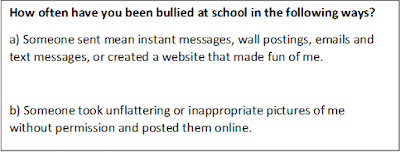Our recent publication is based on a collaborative project between researchers and practitioners to explore the health measures associated with
young people’s use of general practitioner (GP) services in England. The
findings have been published in the Journal of Adolescent Health in a paper entitled
“Experience of primary care services among early adolescents in England and association with health measures”.
There is a gap in knowledge surrounding young people’s experience of GP services in England, with national surveys limited to capturing the experience of patients aged 18 years and over1. For that reason, questions on young people’s use of GP services were added to the 2014 HBSC England survey. The survey initially asks a question on service use – identifying whether young people have had visited their GP in the last year. This is followed up with a number of questions which concern young people’s experience of their last visit to their GP (Figure 1).
There is a gap in knowledge surrounding young people’s experience of GP services in England, with national surveys limited to capturing the experience of patients aged 18 years and over1. For that reason, questions on young people’s use of GP services were added to the 2014 HBSC England survey. The survey initially asks a question on service use – identifying whether young people have had visited their GP in the last year. This is followed up with a number of questions which concern young people’s experience of their last visit to their GP (Figure 1).
 |
| Figure 1. Questions measuring GP service use in the 2014 HBSC England survey |
The majority (80%) of young people
said they had visited their GP in the last year. Respondents reported a largely
positive experience of GP service use; 75% of respondents felt at ease with the
GP during their last visit, 89% felt their GP treated them with respect from GP
and 83% reported they were satisfied with the explanations their GP provided.
However, only just over half (52%) of respondents stated they felt comfortable
talking to their GP about personal things, a finding which seemed fairly
consistent across gender and age (Figure 2). The 2014 HBSC England national report provides a comprehensive account of data on GP service use2.
 |
| Figure 2. Young people who reported they were able to talk to their GP about personal things, by age and gender (graph originates from Brooks et al. 2015) |
One of the aims of our recent
analysis sought to explore whether young people’s perception of GP visits is related to different
health measures; is poor experience of GP service use associated with worse
reports of emotional wellbeing and physical health? The paper examined five
health measures: headaches, sleeping problems, low mood, general self-rated
health and self-harm (among 15 year olds only).
The analysis focussed on the 80% (4149)
young people who reported visiting their GP in the last year. Binary logistic
regression identified respondents who reported poor GP experience were more
likely to report poor health measures, whilst controlling for ethnicity, age,
gender and family affluence. For example, poor ratings on all indicators of GP
experience (Figure 1) were significantly associated with an increased risk of
self-harm, feeling low and sleep problems among young people.
The data collected through HBSC
surveys is cross-sectional and as such we cannot determine the direction of
this relationship. Having poor health may result in a more negative perception
of GP services, or it could be that a poor perception of GP services influences
young people’s health through disengagement and a reduction in use of health
care services.
The findings highlight the
important role GPs may play in young people’s health and wellbeing, and
emphasise the need for health care services to be understanding of the
different skills required for working with young people.
For a through discussion of our findings the
full paper can be accessed by clicking here.
References
- Ipsos_Mori (2016). GP Patient Survey - National summary report. NHS England. Retrieved October, 12, 2016 from http://gp-survey production.s3.amazonaws.com/archive/2016/July/July2016NationalSummaryReport.pdf
- Brooks, F., Magnusson, J., Klemera, E., Chester, K., Spencer, N., & Smeeton, N. (2015). HBSC England national report: Findings from the 2014 HBSC study for England. Hatfield, UK: University of Hertfordshire. Retrieved October, 12, 2016 from http://www.hbscengland.com/wp-content/uploads/2015/10/National-Report-2015.pdf















